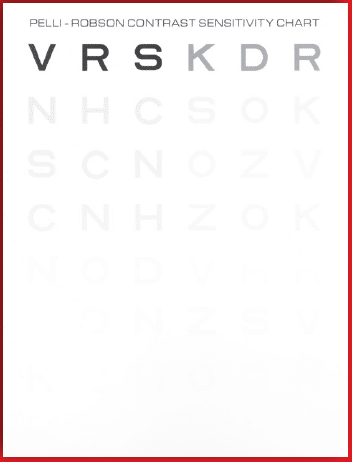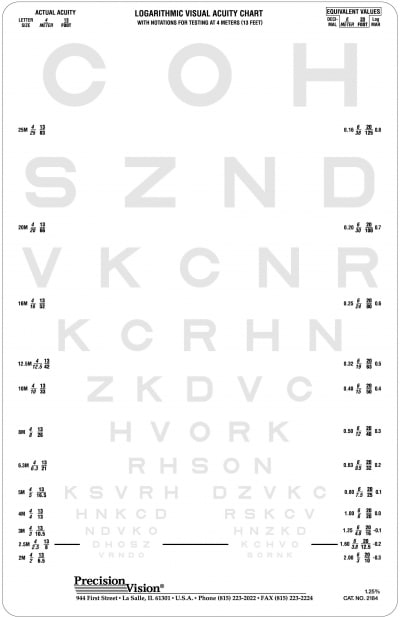
PV News – February 2010 – Reading Cards Compared – Precision Vision
IN THE NEWS
Did you know that Precision Vision is the world leader in reading card production? It’s true. We work with three top vision care professionals to produce and distribute MNread cards, Colenbrander cards, and Radner cards. In this issue we discuss all the differences between them. Also, we hope you’ll join us at the next tradeshow in your area. Read on.
Reading Cards
Precision Vision is by far the world leader in the reading card industry. We offer the top 3 reading card systems developed by top eye care professionals.
MNread cards
MNread were the first modern reading cards to use a logarithmic progression of print sizes. They were developed by Gordon Legge, PhD and his staff at the University of Minnesota (1993). The MNread cards feature print sizes from 8 M to 0.16 M (20/400 to 20/6.3 at 40cm) and are also available in reverse contrast. Similar cards are available in Portuguese, French, Greek, Swedish, Italian, and Japanese and are under development in Spanish. The English cards have been manufactured by Precision Vision for many years and incorporate a durable and cleanable satin finish on the printed surface to extend their service. Soon additional versions of the English text will be available to reduce memorization in repetitive testing conditions such as clinical trials.
Colenbrander Reading cards
A variety of cards were developed by August Colenbrander, MD in San Francisco (1994 – 2008). The series includes cards for Low Vision and for regular practice. The Low Vision cards come with a ruler so that they can be used at any distance; the ruler has a diopter scale to indicate the required reading add. The largest letter size is 10 M (20/2000 at 10 cm, 20/500 at 40 cm). The other cards come with an attached cord to maintain the standard reading distance of 40 cm. The smallest letter size is 0.2 M (20/10 at 40 cm). The cards are available in English, Spanish, Portuguese, French, German, Dutch, Danish, Swedish, Finnish, Italian and Tagalog.
Since contrast sensitivity loss also affects reading ability, the cards are also available in low contrast versions and in the Mixed ContrastTM format which offers high and low contrast side by side for easy comparison.
For the testing of presbyopic and multifocal corrections a card set is available with cords for testing at three standardized distances (40 cm = 2.5 D, 63 cm = 1.5 D, 100 cm = 1 D); they feature the Mixed ContrastTM format to easily test and compare the effect of high and low contrast. All the cards in the Colenbrander series are printed on durable and washable plastic material for many years of service.
Radner cards
This is the latest acquisition to our Reading Card product line.
The Radner Reading Charts system was developed by the Ophthalmologist Wolfgang Radner, MD in Vienna in interdisciplinary cooperation with Psychologists, Linguists, Physicists and Statisticians.
They come in the form of a booklet (size: letter) with three reading cards, a card with numbers, and one with Landolt rings. It also includes clear instructions and evaluation sheets. The Radner sentences offer the most highly standardized grammatical construction. Print sizes vary from 6.3 M to 0.25 M (20/320 to 20/12.5 at 40 cm).
The Radner Charts are available in English, Spanish, Dutch, Swedish, Hungarian and German. A French and Portuguese version is under development.
Differences

While the MNread and Colenbrander cards use a Times Roman font, which is most similar to the newspaper fonts patients want to read, the Radner cards use a sans-serif font, which is slightly easier and more similar to letter chart fonts. The MNread is available in two different sets of sentences.
The MNread card is the only one available in reverse contrast.
The Colenbrander cards are the only ones that come with a cord for the proper reading distance. They also are the only ones available in low contrast and in the Mixed ContrastTM format.
The Radner cards are the only ones that come with three different texts, to avoid learning effects from repetitive testing.
PRODUCT PROFILE
Colenbrander Continuous Text Near Vision Card
Continuous text cards simulate everyday tasks and activities that patients may encounter, such as reading the newspaper. This is important because it is the main part of everyday vision. Also, by testing with continuous text, doctors can establish a basis for prescriptions of magnification for corrective lenses. If everyday vision tasks are made easier, in turn the patient’s life can be easier. M unit letter sizes provide acurate acuity at various distances.
MNRead Chart 1 white text on black backround
Variation in sentences between charts in the same set allows for repeat testing or testing the other eye with less possibility of memorization. The MNRead chart also provides a measurement for reading speed, and comes with preferred scoring procedures and tables for calculating reading speed. This chart also includes information for converting acuity scores at non-standard viewing distances.
SEE PV
Upcoming Tradeshows
Visit Precision Vision at the following tradeshows. If you are attending one of these tradeshows and want to avoid unnecessary shipping costs and delays, we’d be happy to bring small portable products to the meeting. Place your order online or call us at 800-772-9211. Just be sure to tell us which tradeshow to hold the products for.

Share Your Stories With Us!
Precision Vision® wants to hear your stories. Tell us how you are impacting the industry. Do you have an interesting story to share about a Precision Vision® product? Contact us and we may use it in a future newsletter.





